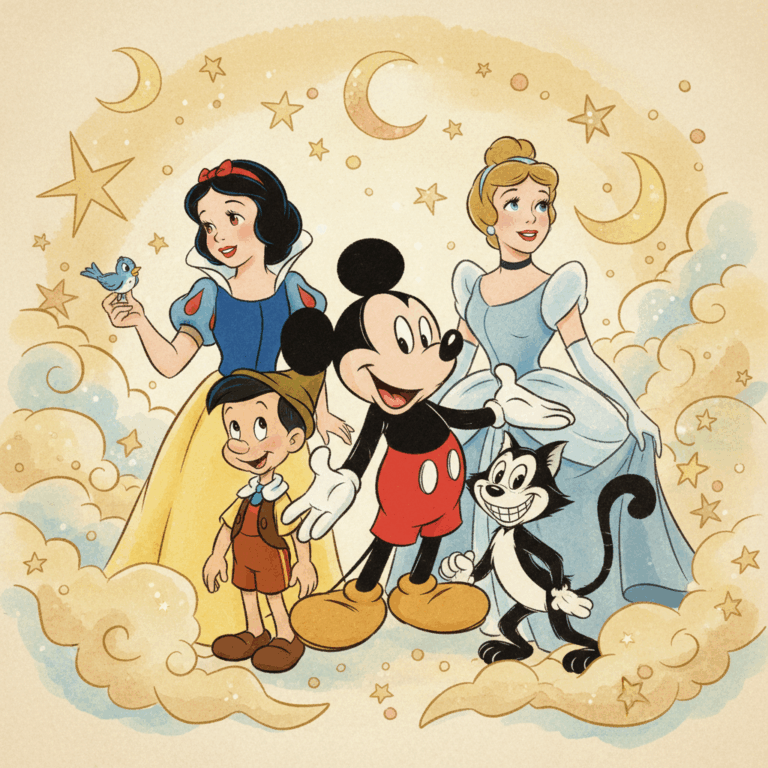Origins and evolution of classic animated cinema
Classic animated films have left an indelible mark on history, influencing generations with their innovation and emotional depth. These films have become universal symbols of narrative and visual art.
From its earliest days, animated film has been able to combine fantasy, music, and heartwarming stories, creating a magical window for audiences of all ages. Its evolution reflects significant technological and cultural changes.
The creation of “Snow White and the Seven Dwarfs” and its impact
“Snow White and the Seven Dwarfs” (1937) was a landmark film, the first animated feature, establishing the genre and Disney's signature narrative style. Its impact on the industry was revolutionary.
The film stood out for its charismatic characters, unforgettable songs, and a unique blend of tenderness and fantasy. Walt Disney established an aesthetic and emotional standard that has been reproduced for decades in animation.
This film proved that animation could be a viable art form for large audiences, paving the way for future projects and establishing animation as a serious and popular film genre.
Innovations and outstanding works in the classic Disney era
Disney's classic era includes works such as "Fantasia" (1940), which fused classical music with animation in an innovative and ahead-of-its-time visual display, still considered an artistic benchmark.
“Sleeping Beauty” (1959) reaffirmed Disney’s unique visual style, standing out for its technical perfection and the work of master animators who defined the studio’s quality for years.
In this stage, classic animation combined technical innovation, exciting storytelling, and careful design, laying the foundation for future creations and consolidating an artistic legacy that endures.
Major international milestones in classic animation
Classic animation has transcended borders, marking global milestones that redefined the genre with innovative and aesthetic contributions. Each studio brought a unique vision, enriching the global landscape.
These milestones reflect the cultural and technological diversity that animation has achieved, focusing on both narrative quality and technical revolution, capturing the attention of audiences of all ages.
The internationalization of animated cinema allowed the exchange of styles and themes, consolidating classics that connect emotionally and endure in the global collective memory.
The revolutionary contribution of Studio Ghibli
Studio Ghibli transformed Japanese animation with works that combine visual beauty and emotional depth, standing out on the international scene with iconic titles.
“Spirited Away” (2001) broke cultural barriers, being acclaimed for its creativity and thematic richness, and consolidated the studio as an essential global reference.
In addition, films such as "Princess Mononoke" and "Grave of the Fireflies" explored complex emotions and historical realities, expanding the spectrum of classic animation.
The rise of digital animation with Pixar
Pixar revolutionized animation by presenting “Toy Story” (1995), the first feature film entirely in 3D, which started a new technological era and innovative narratives.
This technological leap made it possible to tell stories with greater realism and emotion, connecting with audiences of different ages and creating a new visual language in animation.
Subsequent successes such as “Up”, “Wall-E” and “Coco” demonstrated the ability of digital animation to explore deep and universal themes, solidifying Pixar as a world leader.
The consolidation of a new golden age in the 1990s
The 1990s marked a revaluation of classic animated films, with productions that combined technical innovation, iconic music, and captivating narratives, especially at Disney.
“The Lion King” (1994) became one of the most emblematic references, standing out for its emotional power and its intergenerational appeal that resonated worldwide.
This stage consolidated a new golden age where animation regained its brilliance, adapting to new technologies and maintaining the essence that made it unforgettable.
Elements that make a classic unforgettable
An animated classic endures thanks to the perfect integration of music, narrative and aestheticsThese elements create unique experiences that capture the hearts of the audience.
Furthermore, the emotional connection they establish with audiences transcends generations, turning these films into true cultural bridges and shared memories.
The combination of music, narrative, and aesthetics
Music in classic films not only accompanies, but enhances emotions and narrative, making key moments unforgettable and transforming each scene into a complete sensory experience.
The narrative combines universal messages with endearing characters, offering stories that appeal to both children and adults, creating a deep and lasting emotional connection.
Visually, careful aesthetics and innovative art design define the identity of each film, with styles ranging from vibrant fantasy to detailed tenderness, reinforcing its timeless appeal.
The intergenerational and cultural emotional bond
Classic films serve as a link between generations, evoking childhood memories and fostering family dialogues around common values and emotions.
Its universal cultural dimension allows audiences from different places and times to identify with its themes, integrating it into the global collective heritage and affective memory.
Legacy and relevance of classic films
Classic animated films not only represent a visual and narrative art form, but also function as a essential bridge between childhood and collective memory, uniting generations.
Its impact transcends time by evoking deep emotions and shared memories, reinforcing cultural and personal bonds that endure in society.
Its value as a bridge between childhood and collective memory
These classics evoke childhood experiences that are part of emotional treasure of many people, connecting personal memories with a common cultural framework.
The ability of these films to unite different generations allows stories and values to be transmitted and preserved in the global collective memory.
This intergenerational connection fosters dialogue and understanding, where nostalgia becomes a vehicle for cultural and family identity.
Continuous inspiration for new generations and creators
Classic films continue to be a constant source of inspiration for artists and filmmakers, motivating them to innovate while respecting narrative and aesthetic traditions.
Its influence is reflected in the creation of new content that reinterprets universal themes with modern tools, keeping the animated legacy alive.
Thus, these classic works fuel creativity and learning, ensuring that the magic of animation continues to evolve and conquer future audiences.






